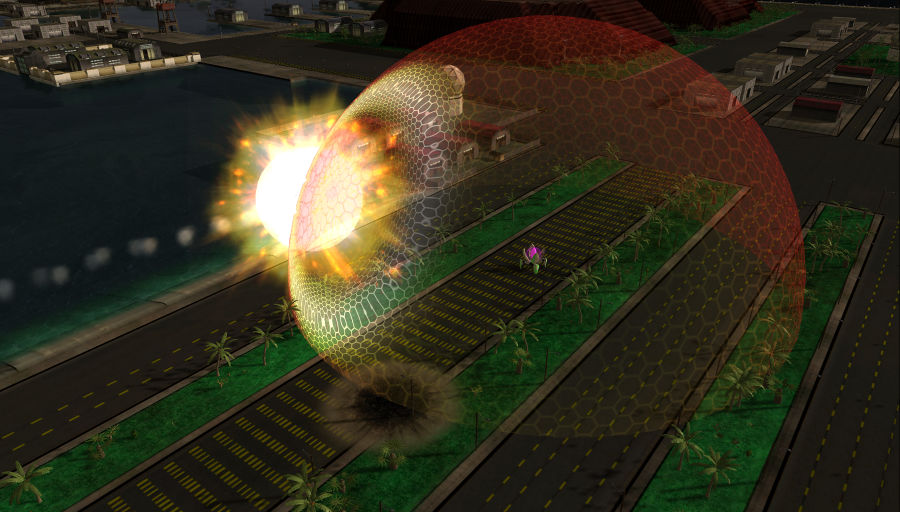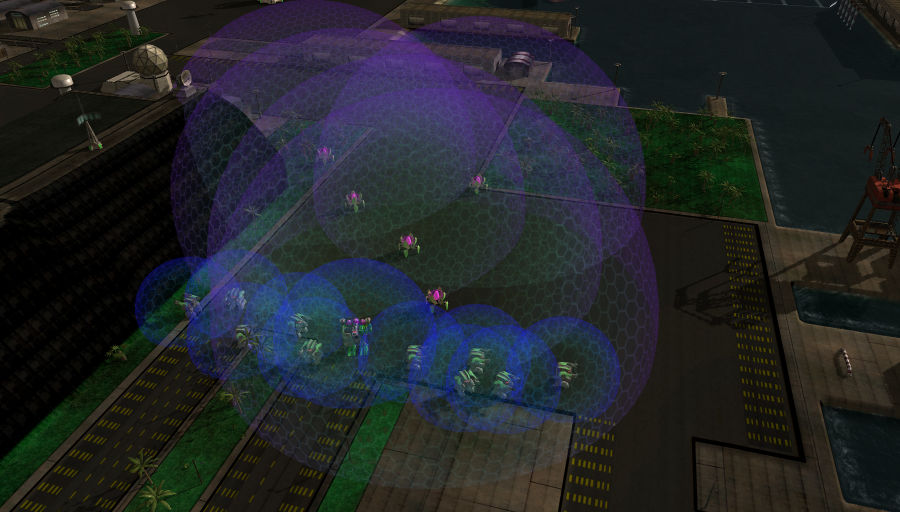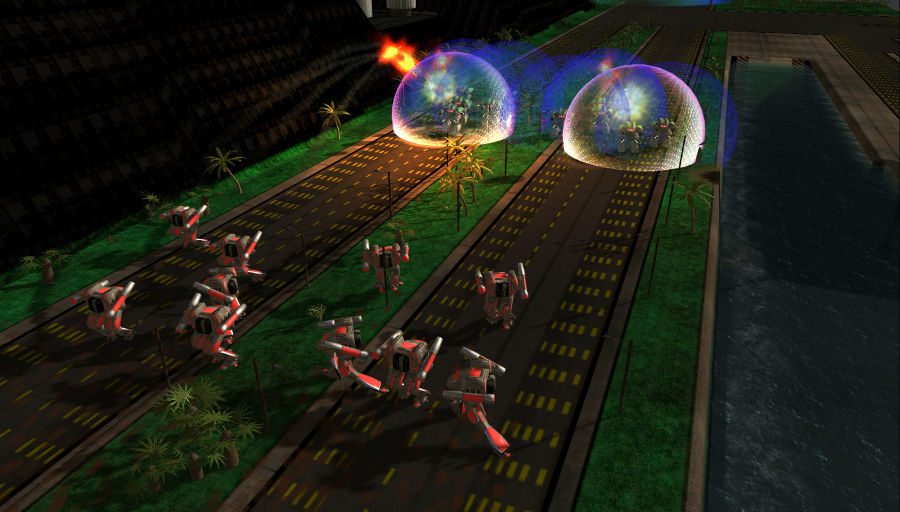Shield
Shields protect units inside by absorbing the damage from attacks in exchange for charge. While shields can stop all but a select few weapons, any area of effect from the detonation will still pass through the shield, so don't expect any units near the edge of the shield area to be completely safe from harm. Shields are spherical and hollow.
Contents
Shield charge[edit]
When shields take damage, their charge is depleted. As the shield charge depletes the shield color will change from blue (full charge) through purple to red (no charge). They will continue to stop weapons until the amount of charge is lower than the damage done by the weapon. There are three types of shield:
- Personal shield - The shield used by the shieldbots Convict, Thug and Felon. This type of shield protects a small area and recharge at no energy cost.
- Area shield - The large bubble shields deployed by Aspis and Aegis. These shields have more charge and drain energy to recharge.
- Funnelweb shield - This is the giant shield mounted on the Funnelweb, a support strider. It has a large charge capacity and radius. It does not link with other shields, and has its recharge interrupted for 10 seconds after receiving damage.
A functioning unit cannot voluntarily disable its shield bubble, which makes shielded units easier to spot from further away and prevents them from being affected by area cloak. Shield regeneration for shields that drain energy to charge can be toggled off and obeys priority.
Commander modules can be equipped to provide either a personal shield or an area shield.
Shield link[edit]
Shields automatically link up to share charge, so if a few shields are taking more damage, charge will flow from the undamaged shields to the damaged shields. There is no limit to how many shields can link together. However, because charge transfers at a finite rate, one shield in a large chain can still be made vulnerable with focused fire. For shields to share charge, they simply need to overlap. Transfer always happens from the shield with more absolute charge (not %) to the one with less.
Shields from any type of unit can link together.
As a shield takes damage it turns red. The shields it is linked to will help recharge it.
In-depth mechanics[edit]
As a general rule every weapon is blocked by shields. When a projectile collides with a shield its damage is compared to the current shield power. If shield power is greater than weapon damage the projectile explodes. Continuous beam lasers that collide with shields drain the shield completely before the beam penetrates it, the beam stops at the shield if intercepted. As the damage exceeds the shield's power, the laser penetrates the shield and deal the remaining damage to the target.
- Shields lose power equal to weapon damage when blocking projectiles.
- The AOE damage of weapons is still dealt to units near the explosion, even those inside the shield.
- Badgers deal damage to shields equal to the total damage of all the missiles shot by the mines they lay.
- Status effects (EMP, Slow and Disarm) weapons damage shields for 1/3 their damage against units. Mixed damage (such as Cutter, Moderator, Knight, or Blitz) deals both the real damage and the 1/3 status effect damage.
- Gauss and flame weapons do 1.5x and 3x their listed damage to shields respectively.
- Melee weapons, disintegrators and the Dominatrix ignore shields.
Shields link by doing the following at a rate of 15 times a second:
- Randomly select a share-partner from the set of adjacent shields. Two shields are adjacent if their bubbles are touching. A shield is considered adjacent to itself.
- Caveat - Felons and area shields only select from the set of adjacent Felons and area shields.
- Determine which of the initial shield and the share-partner has the higher and lower charges.
- Transfer
(high charge - low charge)/100shield charge from the higher charge shield to the lower charge shield.
Shields are considered adjacent to themselves to reduce the transfer rate in situations with a small number of shields. For example, with two shields, self-adjacency effectively halves transfer rate. Felons and area shields are in their own class of shield to reduce the transfer rate between the two classes. Note that Thug and Convict are able to randomly select large shields as a share-partner.
Beating shields[edit]
Area Shield[edit]
Artillery units with high DPS/cost such as Sling can wear a shield down over time. As an added bonus the accuracy of the weapon does not matter because shields are very large, this makes Tremor particularly effective. Disarm bombers (Thunderbirds) are a good example there, as they deal such a staggering amount of disarm damage over large area they become a hard-counter for shield blobs.
AOE weapons in general have poor raw damage so are poor against shields unless you wish to use the AOE to hit something near the edge of the shield.
High burst weapons such as Lance can usually pierce a shield in one shot if the shield power is lowered somewhat first. Tacnuke is another good example, a shield on less than 95% power will let a tacnuke right through.
If your opponent has a shield extending beyond their defence you can move short ranged high DPS units (such as riots) in and attack ground to drain the shield. Make sure to stay out of the range of turrets that are probably within the shield.
Jumping units can jump right into the middle of an area shield and bypass it.
Personal Shield[edit]
Personal shields are weak to the same things as Area Shield as well as a few more. In particular AOE works well against personal shield as the low shield radius will cause a lot of AOE weapons to damage the shield owner even if the projectile explodes on the shield. (In effect, AoE weapons can do damage twice: once to the shield and once to the unit.)
Shield linking means that shield units are typically cramped together. Crawling bombs are exceptionally good against shielded packs if they are planted as landmines.


